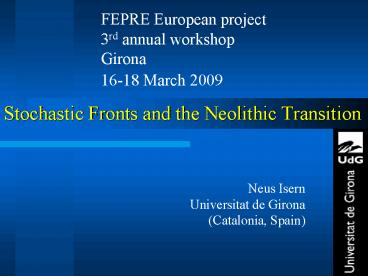Stochastic Fronts and the Neolithic Transition PowerPoint PPT Presentation
1 / 19
Title: Stochastic Fronts and the Neolithic Transition
1
Stochastic Fronts and the Neolithic Transition
FEPRE European project 3rd annual
workshop Girona 16-18 March 2009
- Neus Isern
- Universitat de Girona
- (Catalonia, Spain)
2
Contents
- Stochastic effects on travelling waves
- Stochastic effects on Neolithic transition models
3
Reaction-dispersion fronts
- Physics superconductors, solidification...
- Biological systems viral infections, biological
invasions, tumor growth, Neolithic transition...
Neolithic expansion in Europe
Reaction or reproduction
Dispersion
4
Why a Stochastic Model?
5
Brunet Derrida Deterministic Model
- Brunet E and Derrida B, Shift in the velocity of
a front due to a cutoff Physical Review E 56 2597
(1997)
- Effect of a small cutoff e on the velocity of a
traveling wave in 1D - Fisher-Kolmogorov equation
6
Brunet Derrida Speed Correction
- Front speed correction (general case vv(g))
v0 minimal front speed when and at the
front
Fisher-Kolmogorov equation
7
Brunet Derrida Stochastic Model
- Stochastic dispersion
xj , xk positions of two randomly chosen
particles aj, ak random numbers with value 1
with probability p or 0 with probability 1-p
8
Brunet Derrida Stochastic Results
- Finite number of particles N
- Cutoff e1/N (min. relative density)
Differences due to stochastic effects
9
Application to the Neolithic
10
Evolution Equation
- Reaction logistic growth
- Dispersion kernel
11
Discretization of the Front
- Individuals vs. population density
- Minimum discrete value at the front (at least 1
individual) cutoff - Maximum number (Nmax) of individual per cell.
Stauder J, The Majangir (1971)
12
Discretization of the Front
- Simulations with discretized front
- Dispersion process (pe0.5) (we keep just the
integer part) - Reaction process (we keep just
the integer part)
5
20-40
13
Discretization of the Front
10-15
14
Stochastic Model
- Stochastic Dispersion
- To each individualwe assign a random value
- if a lt pe individuals stay
- if a pe individuals move
- To each migrating individualwe assign a random
value - each corresponding to one of the eight
- possible final positions
15
Stochastic Model
- Simulation results
16
Stochastic Model
- Stochastic Model Deterministic Model
17
Stochastic Model
Isern N, Fort J, Pérez-Losada J J Stat Mechs
(2008)
- Front speed
Mean over 16 stochastic simulations (trun5h)
- Stochastic vs.DeterministicDensity lt 4.2
(pmax range)
13.3
- Stochastic vs. DeterministicIndividuals lt 5
pmax 3288 people/km2 Ammerman A J and
Cavalli-Sforza L L, The Neolithic Transition
and the Genetics of Population in Europe
(1984)
pmax 1.28 people/km2 Currat M and Excoffier
L, Proc. R. Soc. B (2005)
18
Conclusions
- Discretizing the density (num. ind.) introduces a
correction to the front speed. (Up to 40 for low
values pmax.) - The stochastic model introduces correction to the
deterministic model density lying within the
80-CL for the range of pmax for the Neolithic. - Stochastic results follow the behaviour of the
deterministic model with discrete density.
Correction lt5 (16 simulations) for the whole
range of pmax. - Major correction is due to the discretization not
to the stochastic effects.
19
Thanks for the Attention!!

